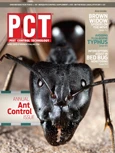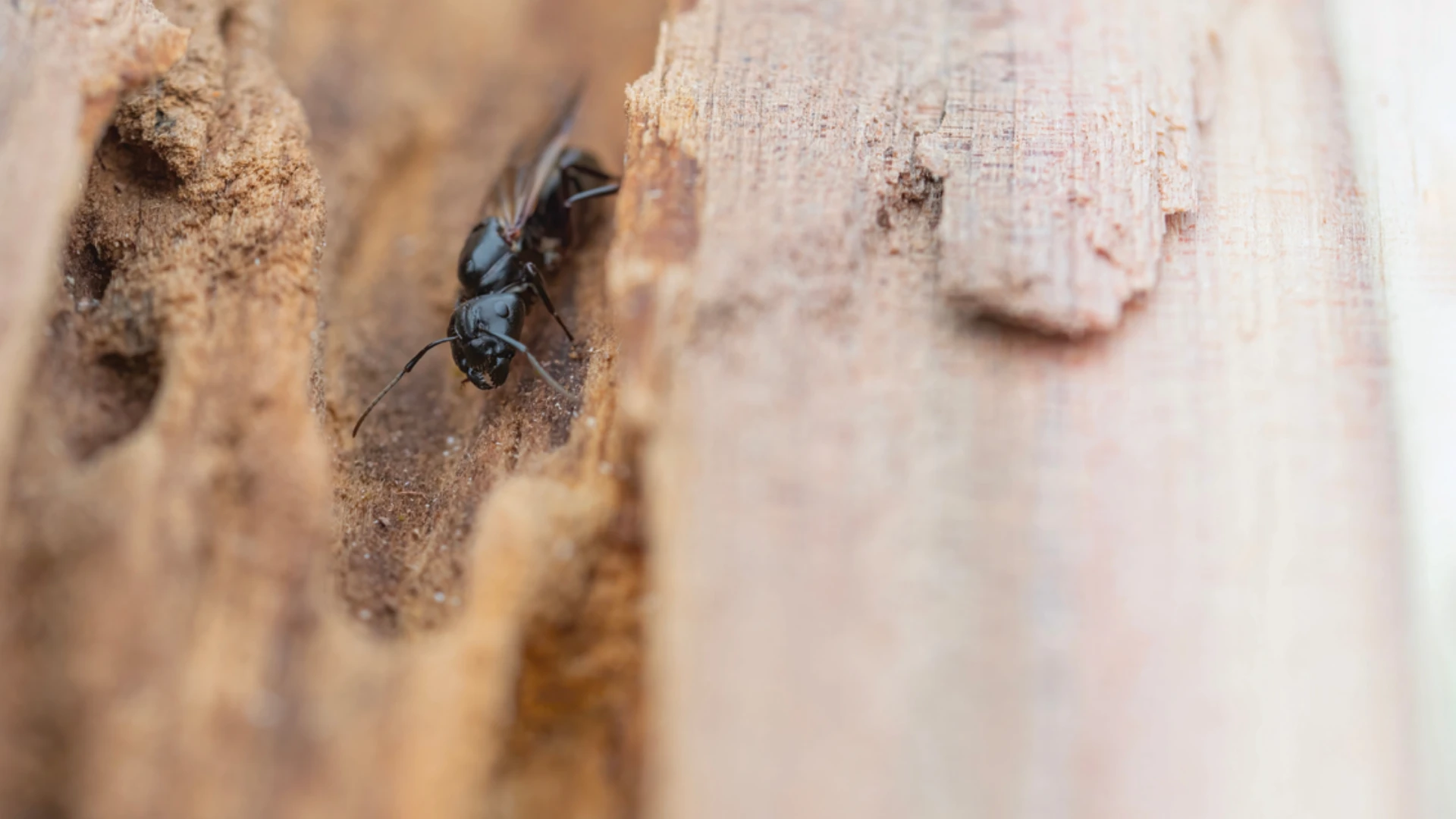For pest management professionals in certain parts of the United States (mainly the Southeast and in California) there is a new nemesis to be aware of, an introduced spider species called the brown widow spider. The brown widow, whose scientific name is Latrodectus geometricus, is closely related to the black widow spider. Pest management professionals who do encounter these spiders should be aware of the following biological and behavioral characteristics of not only Latrodectus geometricus, but of related spider species as well.
DISTRIBUTION. In 2006, a population of brown widow spiders, Latrodectus geometricus (C.L. Koch), was discovered by William Stifter, district manager of the Myrtle Beach, S.C., Dodson Bros. office. In 2007, about 60 specimens were collected by him from the sides of a garage building in Myrtle Beach, S.C., and photographs were taken. This represents the second collection with a documented location for South Carolina. Until the 2008 paper by Brown et al., this species was known to occur primarily in Florida within the United States. Brown et al., added Georgia, Texas, with multiple locations in southeastern Louisiana and Mississippi to the distribution. Brown et al. gave the first documented reference for South Carolina as "collected as far north as Beaufort, S.C., in 2001 (G.B. Edwards, personal communication)" and "collected in multiple locations in Georgia and South Carolina and is widespread in Florida (G. B. Edwards and N.C. Hinkle, personal communication)." Myrtle Beach represents a northward expansion of about 163 miles to the documented brown widow spider distribution in South Carolina.
In 2008, Dodson Bros. Technical Services Director Eric Smith collected specimens from this same Myrtle Beach population and also took photographs. Since May 2007, live female specimens have been maintained in Smith’s lab at Dodson Bros. corporate office in Lynchburg, Va. Stifter has since found them at other sites in the Myrtle Beach area. Rick Vetter, entomologist and spider expert from the University of California, Riverside, has concurred with the identification and has voucher specimens.
WIDOW SPIDERS IN THE U.S. There are five species of widow spiders known to occur in the United States. A very brief description based on female coloration is given here, but it must be realized that color and markings are not always reliable characteristics for species separation. Species separation is based primarily on male genitalia, and males are usually colored and marked quite differently than females (Smith and Whitman 2007). These widow spiders are:
1) The red widow, Latrodectus bishopi (Kaston). This spider’s cephalo-thorax is reddish and its abdomen is black with reddish to orangish spots outlined by white, with red marks on the underside, and its legs are reddish. It occurs only in central and southern Florida.
2) The brown widow, Latrodectus geometricus (Fabricius). The color of this spider is light tan to dark brown or almost black. It has an abdomen with three white spots on top, with a median white band on its rear, with four diagonal white bands on either side, and with an orange (yellow-orange to orange-red) hourglass mark on underside. Its legs are dark-banded or ringed. It occurs along the Gulf Coast of Texas, Louisiana, and Mississippi (plus northward in Pelahatchie/Rankin Co. and Southaven/Desoto Co.), Georgia (southern area, plus Atlanta and Athens), in Florida from Jacksonville southward, in South Carolina (Beaufort and now Myrtle Beach), and recently has been established in Southern California from San Diego to Los Angeles.
3) The western widow, Latrodectus hesperus (Chamberlin and Ivie). This spider is blackish, and its abdomen has a (usually complete) ventral red hourglass mark, with its forward triangular part longer and broader than the rearward triangle. A red spot above the anal tubercle (just above spinnerets) usually is absent. It occurs in the western U.S. and western Canada.
4) The southern black widow, Latrodectus mactans (Fabricius). This spider is blackish and its abdomen has a complete ventral red hourglass mark, with its rearward half more a rounded rectangle than a triangle. Oftentimes, there is a red spot just above the anal tubercle (just above spinnerets) and/or with a row of red spots dorsally along the midline. The southern black widow occurs primarily from Massachusetts to Florida and west to Texas, Oklahoma, and Kansas, but is most common in the southern states.
5) The northern black widow, Latrodectus various (Walckenaer). This spider is blackish in color. Its abdomen usually has a separated red hourglass mark, having the rearward mark triangular and the forward mark rounded, and on top with a row of red spots along the midline and diagonal white bands on either side. The northern black widow occurs in the same areas as the southern black widow, but is also found in the northern states and in Canada and is more common in the northern states.
EASY IDENTIFICATION. The easiest way to separate the brown from other widow spiders is by examining their respective egg sacs. The egg sac of the other widow spiders has a somewhat smooth, coarsely woven white to tan surface and is teardrop to spherical in shape. The egg sac of the brown widow is beige to off-white in color and spherical in shape, but its outer surface has numerous distinctive pointed or spine-like projections.
For the brown widow, it should be noted that there is a dark color variation of females that is almost black, so it very closely resembles the black widow except that its hourglass is orangish and its legs still show faint banding.
WEB AND HARBORAGE. The brown widow spider constructs its web in secluded, protected sites primarily around homes, buildings, and other man-made structures, but Santana (2007) also reports them occasionally on vegetation. Their webs are irregular in shape, usually about 6-12 inches (15-30 cm) in diameter, and they have a concealed silken retreat. They typically spend daylight hours in their retreats and come out on their webs at night where they hang in an inverted or upside-down position awaiting a prey item to get caught in their web. However, they will come out during daylight for snared prey. Their egg sacs are also usually located in their retreats.
Smith and Stifter have found brown widow spiders under eaves and along the eave-gutter junction, under protected door overhangs, extending from under loose metal siding on commercial structures, on the underneath side of picnic tables, and in/underneath undisturbed debris. In addition, Santana (2007) reports them found inside old tires, empty buckets and nursery pots, mail boxes, underneath outdoor chairs, behind hurricane shutters, and on the undercarriages of motor homes among other places. Inside, Smith and Stifter have found them in office spaces in corners and along the doorframe-wall junction of entrance doors, and in a storage room of an athletic facility underneath and among stored chairs. In addition, Santana (2007) found them in cluttered storage closets and inside garages.
BITE RISK. Brown widow spiders are rather timid, quickly withdrawing into their silken retreat when disturbed. They exhibit this same behavior within a few seconds of lights being turned on in a dark room. With continued disturbance, they do not defend their web but instead typically retract their legs, drop from their web, and play dead for some time. Bites occur almost exclusively when the spiders are trapped against bare skin (Brown et al., 2008).
VENOM. The venom of the brown widow has been reported as being the most lethal of five species tested (numbers 1,2,4,5 on page 76, and L. tredecimguttatus) based on LD50s in mice (McCrone 1964). Santana (2007) states the Dr. G.B. Edwards of the Florida State Collection of Arthropods says that its venom is twice as potent as that of the black widow. Of the five species tested previously, the brown widows contained on average the least amount of venom per spider (McCrone 1964).
Reactions in humans tend to be localized to the bite site, with systemic reactions restricted primarily to the young (Müller 1993). Given that in these 45 cases localized reactions were the norm (Müller 1993) and that only a small amount of venom is produced (McCrone 1964), the usual assumption is that less venom is injected with each bite in comparison to black widow spiders. However, Goddard et al. (2008) reported the case of a severe reaction to a brown widow bite in an adult male that required hospitalization, and suggest a need to re-evaluate the current idea that brown widow bites are of minor consequence.
Smith is director of Technical Services for Lynchburg, Va..-based Dodson Bros., and can be contacted at esmith@giemedia.com. Stifter is the Myrtle Beach District Manager for Dodson Bros., and can be contacted at wstifter@giemedia.com.
References cited:
Brown, K.S., J.S. Necaise, and J. Goddard. 2008. Additions to the known U.S. distribution of Latrodectus geometricus (Araneae: Theridiidae). J. Economic Ent., 45(5):959-962.
Goddard, J., S. Upshaw, D. Held, and K. Johnnson. 2008. Severe reaction from envenomation by the brown widow, Latrodectus geometricus (Araneae: Theridiidae). South Med. J. 101(12): 1269-70.
McCrone, J.D. 1964. Comparative lethality of several Latrodectus venoms. Toxicon 2:201-203.
Müller, G.J. 1993. Black and brown widow spider bites in South Africa: a series of 45 cases. South African Med. J. 83:399-4-5.
Santana, F. 2007. Brown widow spiders. Univ. of Florida, IFAS Extension. 3pp.
Smith, E.H. and R.C. Whitman. 2007. NPMA field guide to structural pests., 2nd ed., NPMA, Fairfax, Va. 882pp.

Explore the April 2009 Issue
Check out more from this issue and find your next story to read.
Latest from Pest Control Technology
- Rose Pest Solutions Becomes Official Pest Provider of Chicago Fire FC
- WSPMA Hosts Legislative Day at Washington State Capitol
- A-1 Pest Control Marks 59 years in Business
- Hawaii PCO Shares Regulatory Challenges, Business Impacts from Lahaina Wildfires
- 5 Tips for Reducing Waste in the Office and in the Field
- OvoControl Now Available in Chile
- Envu Announces Savings Programs for Pest Management Professionals
- Follow the Trail





